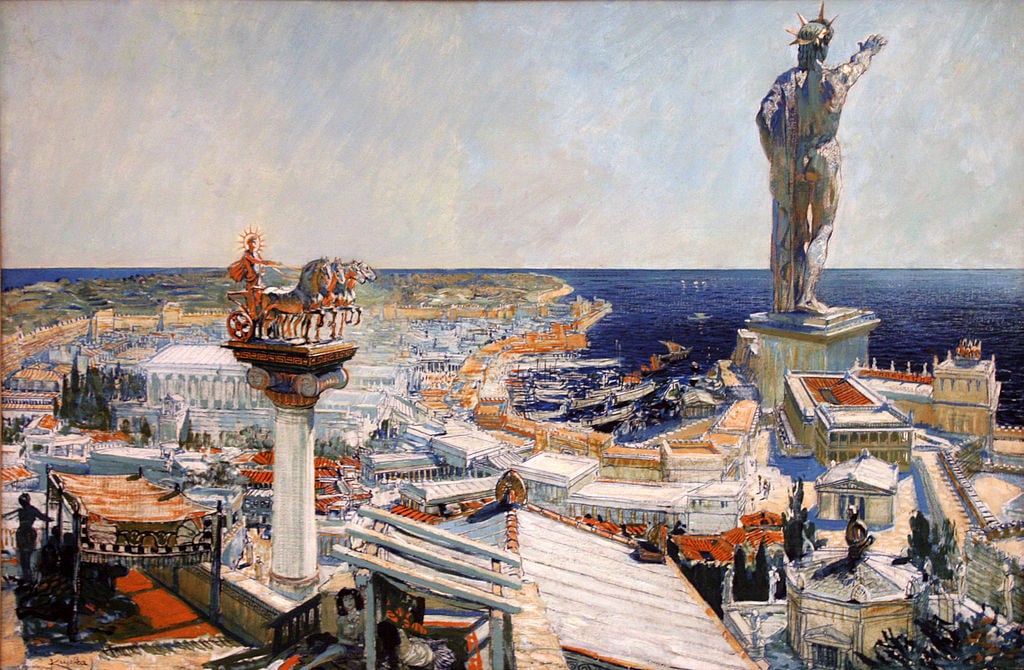Ancient Greece, the cradle of Western civilization, was responsible for creating five of the Seven Wonders of the ancient world. Along with the Great Pyramid at Giza and the Hanging Gardens of Babylon, they rank as the most stupendous achievements ever created in ancient times — and truthfully, they still stand even today as the ultimate monuments to what human beings are capable of.
The Seven Wonders of the Ancient World include the Great Pyramid of Giza, the Hanging Gardens of Babylon (whose existence is still in question), the Temple of Artemis, the Statue of Zeus at Olympia, the Mausoleum at Halicarnassus, the Colossus of Rhodes, and the Lighthouse of Alexandria.
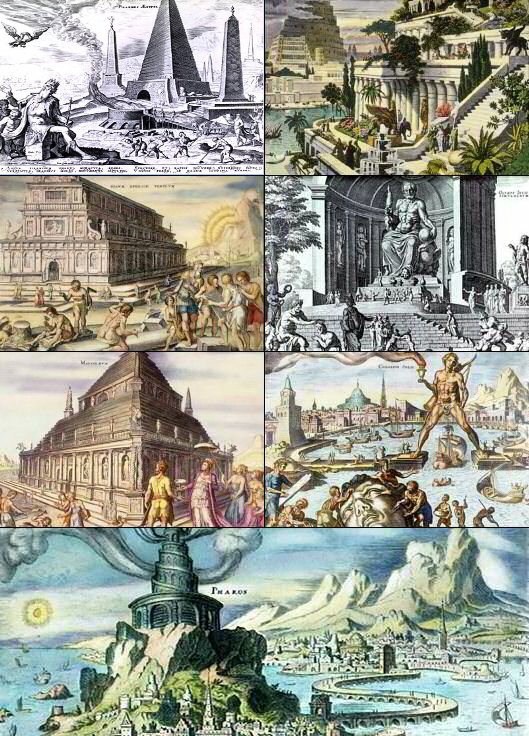
The Seven Wonders of the World, sometimes called the Seven Wonders of the Ancient World, is a list of the most remarkable buildings and monuments of classical antiquity as described by various authors in guidebooks or poems that were popular among ancient Hellenic tourists.
Although the list, in its current form, was not agreed upon in its entirety until the Renaissance, the first such lists of Seven Wonders date back to the 2nd to 1st century BC.
The original list inspired innumerable versions through the ages. Of the original Seven Wonders, tragically, only one — the Great Pyramid of Giza, the oldest of all the ancient wonders — remains relatively intact.
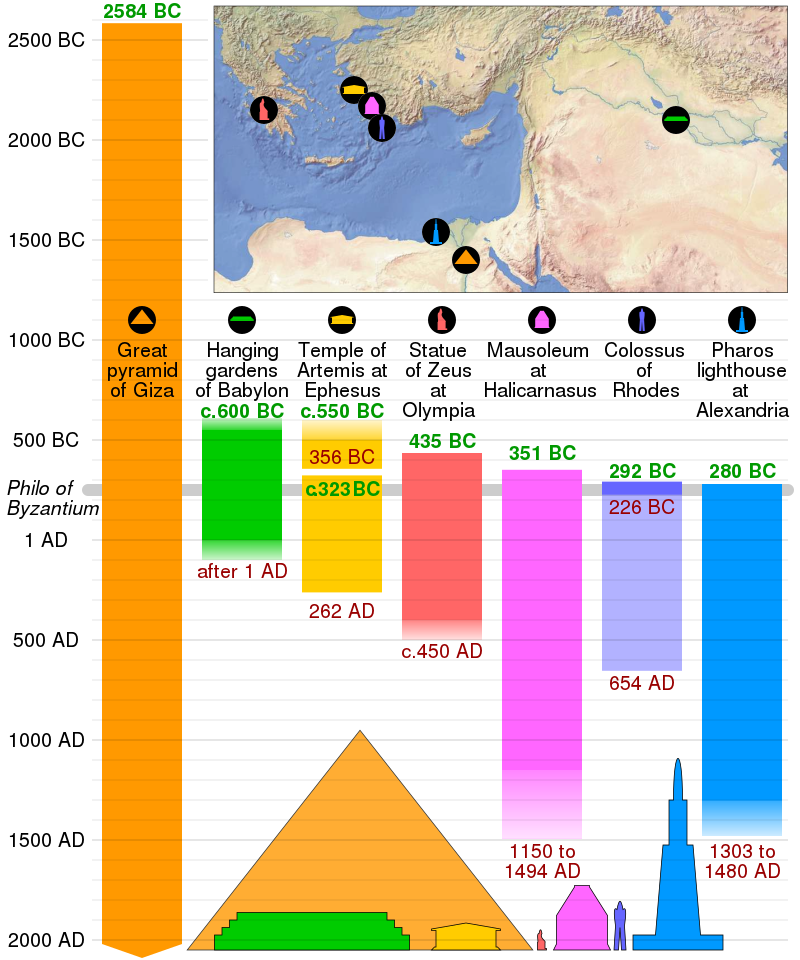
Tragically, the Colossus of Rhodes, the Lighthouse of Alexandria, the Mausoleum at Halicarnassus, the Temple of Artemis and the Statue of Zeus — all the Wonders created by Greek peoples — have all been destroyed, through wars, floods, earthquakes, or just the ravages of time itself.
Intriguingly, the location and ultimate fate of the Hanging Gardens of Babylon are unknown, and some continue to speculate that this one of the Seven Wonders of the World may not even have existed at all.
Appreciation for Seven Wonders of the Ancient World Spurred by Travelogues
The Greek conquest of much of the western world in the 4th century BC gave Hellenistic-era travelers access to the civilizations of the Egyptians, Persians, and Babylonians. Impressed and captivated by the landmarks and marvels of the various lands, these travelers began to list what they saw to remember them.
Instead of “wonders,” the ancient Greeks spoke of “theamata” (θεάματα), which means “sights”, in other words “things to be seen” (Τὰ ἑπτὰ θεάματα τῆς οἰκουμένης [γῆς] Tà heptà theámata tēs oikoumenēs [gēs]). Later, the word for “wonder” (“thaumata” θαύματα, “wonders”) was used. The list was meant to be the Ancient World’s counterpart to a travel guidebook of essential things that must be seen firsthand, or read about, for any cultured person.
The first reference to a list of seven such monuments was given by Diodorus Siculus, a Greek historian from Sicily, in his monumental work Bibliotheca Historica. The epigrammist Antipater of Sidon, a Greek poet who lived around or before 100 BC, created a list of seven “wonders”, including six of the present list, substituting the walls of Babylon for the Lighthouse of Alexandria.
“The Sun Himself Has Never Looked Upon Its Equal”
In his work Greek Anthology, he states: “I have gazed on the walls of impregnable Babylon along which chariots may race, and on the Zeus by the banks of the Alpheus, I have seen the hanging gardens, and the Colossus of the Helios, the great man-made mountains of the lofty pyramids, and the gigantic tomb of Mausolus; but when I saw the sacred house of Artemis that towers to the clouds, the others were placed in the shade, for the sun himself has never looked upon its equal outside Olympus.”
Another 2nd century BC writer, who may or may not be “Philo of Byzantium,” wrote a short account entitled “The Seven Sights of the World.” Unfortunately, the surviving manuscript we have is incomplete, missing its latter pages, but from the text of the preamble we can see that the list of seven sights exactly matches Antipater’s.
Earlier and later lists by the Greek historian Herodotus (c. 484 BC–c. 425 BC) and the poet Callimachus of Cyrene (c. 305–240 BC), housed at the Museum of Alexandria, tragically survive only as references in other works.
The Colossus of Rhodes was the last of the Seven Wonders to be completed, after 280 BC — and the first to be destroyed, by an earthquake in 226/225 BC. Perhaps what is most remarkable of all is that all the seven wonders existed at the same time for a period of less than 60 years — but they live on as part of the historical record until today.
The primary accounts, coming from Hellenistic writers, also heavily influenced the places included in the Wonders list. Five of the seven entries are a celebration of the greatest Greek accomplishments in the arts and architecture.

Great Pyramid of Giza
Built in 2584–2561 BC by the ancient Egyptians and still in existence, the majority of the Great Pyramid’s façade is unfortunately gone. Located in the Giza Necropolis, Egyptologists conclude that the pyramid was built as a tomb for the Fourth Dynasty Egyptian pharaoh Khufu. They believe it was built in the 26th century BC, taking approximately 27 years to construct.
Initially standing at 146.5 meters (481 feet) tall, the Great Pyramid was the tallest man-made structure in the entire world for more than 3,800 years, earning its position at the top of the Seven Wonders of the World.
There are three known chambers inside the Great Pyramid. The lowest was cut into the bedrock, upon which the pyramid was built, but remained unfinished. The so-called Queen’s Chamber and King’s Chamber, that contains a granite sarcophagus, are higher up, within the pyramid structure.
Khufu’s vizier, Hemiunu (also called Hemon), is believed by some to be the architect of the Great Pyramid. Many varying scientific and alternative hypotheses attempt to explain the exact construction techniques.
The funerary complex around the pyramid consisted of two mortuary temples connected by a causeway (one close to the pyramid and one near the Nile), tombs for the immediate family and court of Khufu, including three smaller pyramids for Khufu’s wives, an even smaller “satellite pyramid” and five buried solar barges.
The Hanging Gardens of Babylon
Believed to have been constructed by the Babylonians or Assyrians sometime around 600 BC, they were tragically destroyed after the 1st century AD. Their exact location is unknown but is speculated to be somewhere in Hillah or Nineveh, Iraq. It is believed that they were portrayed on an Assyrian wall relief located in the ancient city of Nineveh (modern-day Mosul, Iraq).
They were described as a remarkable feat of engineering with an ascending series of tiered gardens containing a wide variety of trees, shrubs, and vines, resembling a large green mountain constructed of mud bricks.
The Hanging Gardens’ name is derived from the Greek word κρεμαστός (kremastós, literally ’overhanging’), which has a broader meaning than the modern English word “hanging” and refers to trees being planted on a raised structure such as a terrace.
According to one legend, the Hanging Gardens were built alongside a grand palace known as The Marvel of Mankind, by the Neo-Babylonian King Nebuchadnezzar II (who ruled between 605 and 562 BC), for his Median wife Queen Amytis, because she missed the green hills and valleys of her homeland.
This was attested to by the Babylonian priest Berossus, writing in about 290 BC, a description that was later quoted by the Roman Jewish historian Josephus. The construction of the Hanging Gardens has also, however, been attributed to the legendary queen Semiramis, who supposedly ruled Babylon in the 9th century BC, and they have been called the Hanging Gardens of Semiramis as an alternative name.
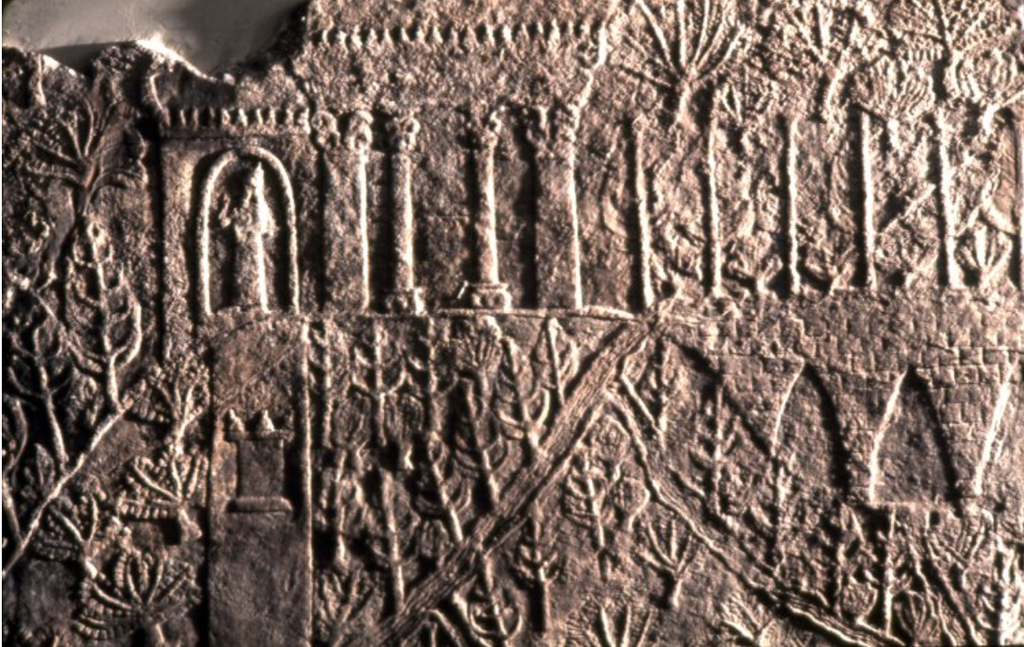
The Temple of Artemis at Ephesus
Constructed c. 550 BC and again in 323 BC by the Greeks, destroyed by arson in 356 BC by Herostratus, this jewel, another of the Seven Wonders of the World, was rebuilt, but again destroyed in AD 262 by the invading Goths.
The Temple of Artemis or Artemision (Greek: Ἀρτεμίσιον), also known as the Temple of Diana, was a Greek temple dedicated to an ancient, local form of the goddess Artemis.
It was located in Ephesus (the modern town of Selçuk in present-day Turkey). It was completely rebuilt twice, once after a devastating flood and three hundred years later after an act of arson, and in its final form was recognized as one of the Seven Wonders of the Ancient World.
By 401 AD, it had been ruined or destroyed for the most part. Only foundations and fragments of the last temple remain at the site today, as seen in the image below, taken in 2017.
The earliest version of the temple (a temenos) predated the Ionic immigration by many years, and dates back to the Bronze Age. Callimachus, in his work Hymn to Artemis, attributed it to the mythical Amazons.
It was completely destroyed by a flood in the 7th century BC. Its reconstruction, in more grandiose form, began again around 550 BC, under Chersiphron, the Cretan architect, and his son Metagenes. The project was funded by Croesus of Lydia, and took 10 years to complete.
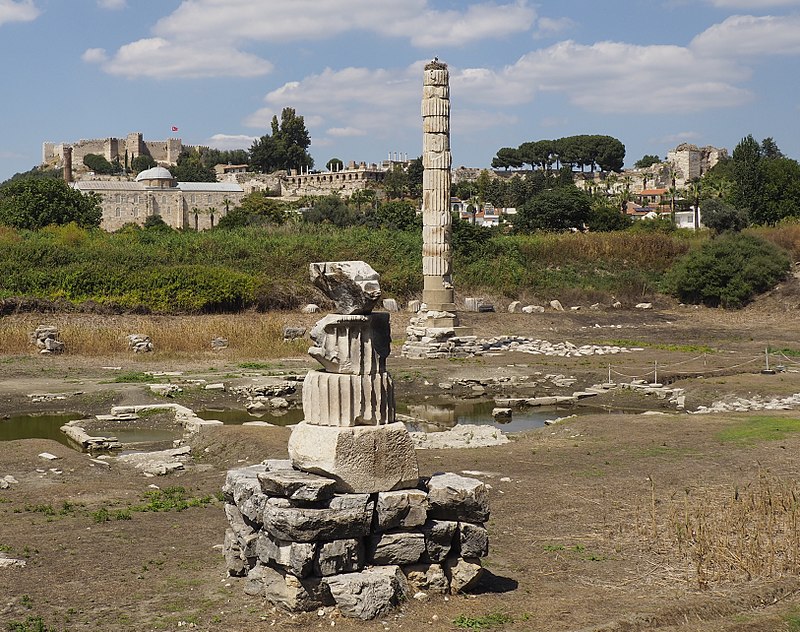
It was this version of the temple that was destroyed in 356 BC by Herostratus in an act of arson.
His heinous act prompted the creation of a “damnatio memoriae” law forbidding anyone to mention his name, orally or in writing. (Interestingly, another historical figure who was subject to the “Damnation of memory” law was the infamous Roman emperor Nero, who burned down much of central Rome to make a palatial new palace.)
The next, greatest, and last form of the temple, funded by the Ephesians themselves, is described in Antipater of Sidon’s list of the world’s Seven Wonders in his work Greek Anthology:
“I have set eyes on the wall of lofty Babylon on which is a road for chariots, and the statue of Zeus by the Alpheus, and the hanging gardens, and the colossus of the Sun, and the huge labour of the high pyramids, and the vast tomb of Mausolus; but when I saw the house of Artemis that mounted to the clouds, those other marvels lost their brilliancy, and I said, “Lo, apart from Olympus, the Sun never looked on aught so grand.”
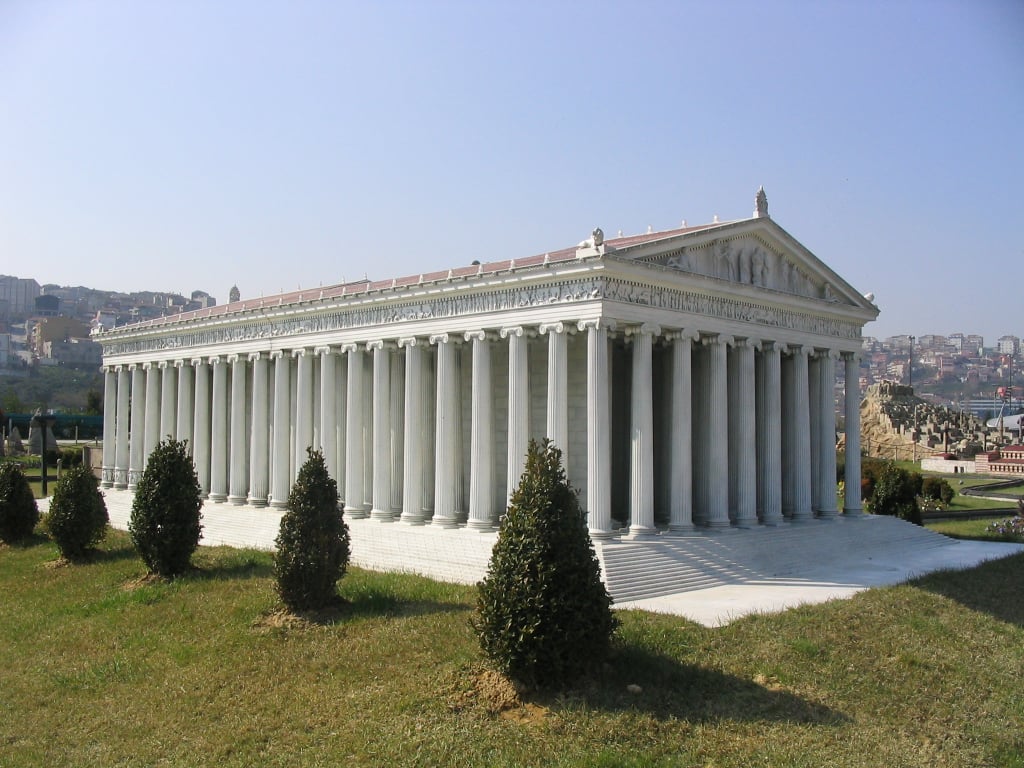
Statue of Zeus at Olympia
The Temple to Zeus at ancient Olympia was built in 466–456 BC; the colossal statue of Zeus was created in 435 BC by the Greek master sculptor Phidias.
Zeus was the god of the sky and thunder in ancient Greek religion, who ruled as king of all the gods on Mount Olympus.
This statue was a chryselephantine sculpture of ivory plates and gold panels atop a wooden framework. Zeus sat on a painted cedarwood throne ornamented with ebony, ivory, gold and precious stones.
The priceless statue was lost and destroyed by unknown individuals during the 5th century AD; the only way we can know how it looked are from ancient Greek descriptions and representations on coins.

The 2nd-century AD geographer and traveler Pausanias left a detailed description of this staggering sight in his seminal work, Description of Greece: “The statue was crowned with a sculpted wreath of olive sprays and wore a gilded robe made from glass and carved with animals and lilies.
“Its right hand held a small chryselephantine statue of crowned Nike, goddess of victory; its left a scepter inlaid with many metals, supporting an eagle. The throne featured painted figures and wrought images and was decorated with gold, precious stones, ebony, and ivory.”
Zeus’ golden sandals rested upon a footstool decorated with an Amazonomachy in relief. The passage underneath the throne was restricted by painted screens.
Pausanias also recounts that the statue was kept constantly coated with olive oil to counter the harmful effect on the ivory caused by the “marshiness” of the Altis grove. The floor in front of the image was paved with black tiles and surrounded by a raised rim of marble to contain the oil. This reservoir acted as a reflecting pool which doubled the already-imposing height of the statue.
According to the Roman historian Livy, in his tome “Ab Urbe Condita,” the Roman general Aemilius Paullus (the victor over Macedon) saw the statue and “was moved to his soul, as if he had seen the god in person”, while the 1st-century AD Greek orator Dio Chrysostom declared that a single glimpse of the statue would make a man forget all his earthly troubles.
According to legend, when the sculptor Phidias was asked what inspired him — whether he climbed Mount Olympus to see Zeus, or whether Zeus came down from Olympus so that Phidias could see him — the artist simply answered that he portrayed Zeus according to Book One, verses 528–530 of Homer’s Iliad:
“ἦ καὶ κυανέῃσιν ἐπ’ ὀφρύσι νεῦσε Κρονίων
ἀμβρόσιαι δ’ ἄρα χαῖται ἐπερρώσαντο ἄνακτος
κρατὸς ἀπ’ ἀθανάτοιο μέγαν δ’ ἐλέλιξεν Ὄλυμπον.”
“He spoke, the son of Cronos, and nodded his head with the dark brows,
and the immortally-anointed hair of the great god
swept from his divine head, and all Olympos was shaken.”
Olympian Zeus may have been Carted off to Constantinople, Destroyed by Fire
In 391 AD, the Christian Roman emperor Theodosius I banned participation in pagan cults and closed the temples. The sanctuary at Olympia fell into disuse. The circumstances of the statue’s eventual destruction are unknown.
The 11th-century Byzantine historian Georgios Kedrenos records a tradition that it was carried off to Constantinople, where it was destroyed in the great fire of the Palace of Lausus, in 475 AD.
Alternatively, the statue may have been destroyed along with the temple, which was severely damaged by fire in 425 AD. But earlier loss or damage is implied by Lucian of Samosata in the later 2nd century, who referenced it in Timon, saying: “they have laid hands on your person at Olympia, my lord High-Thunderer, and you had not the energy to wake the dogs or call in the neighbors; surely they might have come to the rescue and caught the fellows before they had finished packing up the loot.”
We may have a surviving link to this lost Wonder of the World by way of a recent remarkable discovery. The approximate date of the statue, the third quarter of the 5th century BC, was confirmed in the rediscovery in 1954 of Phidias’ workshop, approximately where Pausanias said the statue of Zeus had been constructed.
Archaeological finds at the site included tools for working gold and ivory, ivory chips, precious stones and terracotta molds. Most of the latter were used to create glass plaques, and to form the statue’s robe from sheets of glass, which were naturalistically draped and folded, then gilded. A cup inscribed “ΦΕΙΔΙΟΥ ΕΙΜΙ” or “I belong to Phidias” was even found at the site.
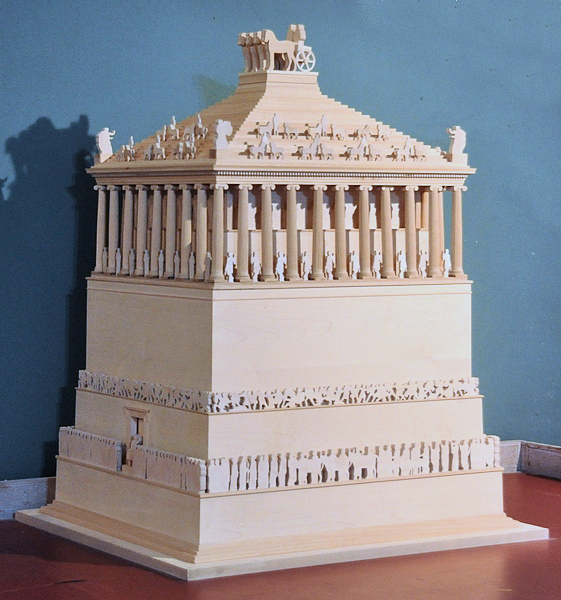
The Mausoleum at Halicarnassus
The Mausoleum was a tomb built between 353 and 350 BC in Halicarnassus (present-day Bodrum, Turkey) for Mausolus, a native Anatolian from Caria and a satrap in the Achaemenid Empire, and his sister-wife Artemisia II of Caria.
The structure was designed by the Greek architects Satyros and Pythius of Priene.
The Mausoleum was approximately 45 meters (148 feet) in height, and the four sides were adorned with sculptural reliefs, each created by one of four Greek sculptors: Leochares, Bryaxis, Scopas of Paros, and Timotheus.
The mausoleum was considered to be such an aesthetic triumph that Antipater of Sidon identified it as one of his Seven Wonders of the Ancient World. It was destroyed by successive earthquakes from the 12th to the 15th century — the last monument to survive of all the six destroyed Wonders.
Because of the fame of this building, the word mausoleum has now come to be used generically for an above-ground tomb all around the world.
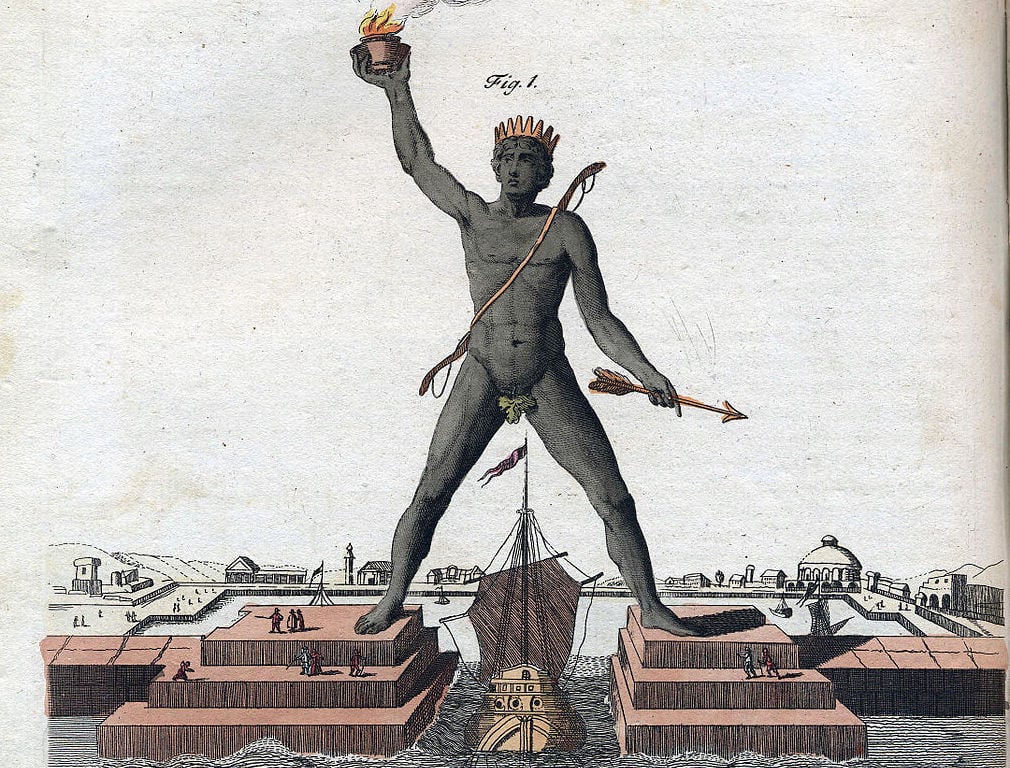
The Colossus of Rhodes
Built from 292–280 BC by the Greeks, the Colossus sadly survived only several decades before it was destroyed in 226 BC 226 BC by the Rhodes earthquake.
The Colossus was a representation of the Greek sun-god Helios, erected in the city of Rhodes, on the Greek island of the same name, by Chares of Lindos in 280 BC. One of the Seven Wonders of the Ancient World, it was constructed to celebrate the successful defense of Rhodes city against an attack by Demetrius Poliorcetes, who had besieged it for a year with a large army and navy.
According to most contemporary descriptions, the Colossus stood approximately 70 cubits, or 33 meters (108 feet) high – approximately the height of the modern Statue of Liberty from feet to crown – making it the tallest statue in the ancient world.
The gigantic statue tragically collapsed during the earthquake of 226 BC, although parts of it were preserved. In accordance with an oracle, the Rhodians did not build it again. The magnificent statue has also gone down into history because Rhodians began to be called Colossaeans, or Colossians, since they had erected the famous statue on the island.
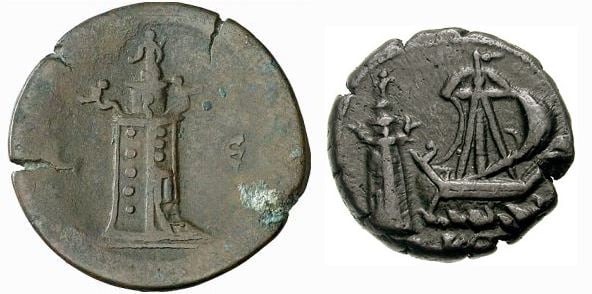
The Lighthouse of Alexandria
Built c. 280 BC by the Greeks and Ptolemaic Egyptians, it survived until AD 1303–1480 after the cataclysm of the Crete earthquake.
Built in Alexandria, Egypt, with a fire atop it to warn mariners of the rocky shoreline below it, the lighthouse, whose Greek name has come to epitomize the word lighthouse in many languages (Ancient Greek: ὁ Φάρος τῆς Ἀλεξανδρείας), this was a structure built by the Ptolemaic Kingdom, during the reign of Ptolemy II Philadelphus (280–247 BC).
The lighthouse at Alexandria has been estimated to be at least a towering 100 meters (330 feet) in overall height. Another one of the Seven Wonders of the Ancient World, for many centuries it was one of the tallest man-made structures in the entire world.
The lighthouse was severely damaged by three earthquakes between 956 AD and 1323 that it tragically became an abandoned ruin after that time. It was the third-longest surviving ancient wonder (after the Mausoleum at Halicarnassus and the extant Great Pyramid of Giza), surviving in part until 1480, when the last of its remnant stones were used to build the Citadel of Qaitbay on the site.
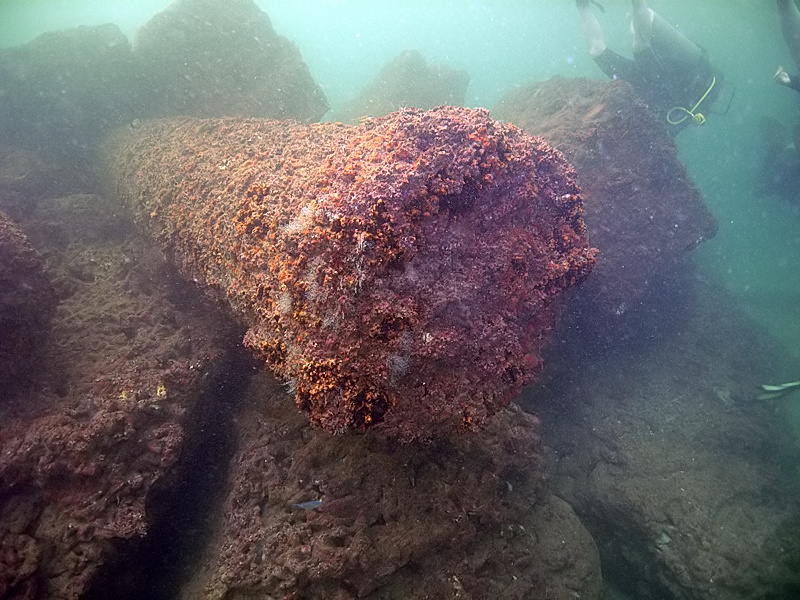
However, in 1994, a team of French archaeologists dove into the waters of Alexandria’s Eastern Harbor and discovered some remains of the original lighthouse lying right where they had hit the sea floor after the great quake in the 1300s.
According to Smithsonian Magazine, recent dives by French underwater archaeologist Franck Goddio have revealed statues depicting the faces of Ptolemy and Cleopatra, asm well as falcon-headed crocodile sphinxes and priests holding canopic jars.
The Ministry of State of Antiquities in Egypt plans to turn the submerged ruins of ancient Alexandria, including those of the Pharos, into an underwater museum that would make the stones of the lighthouse visible to the public for the first time in 1400 years.
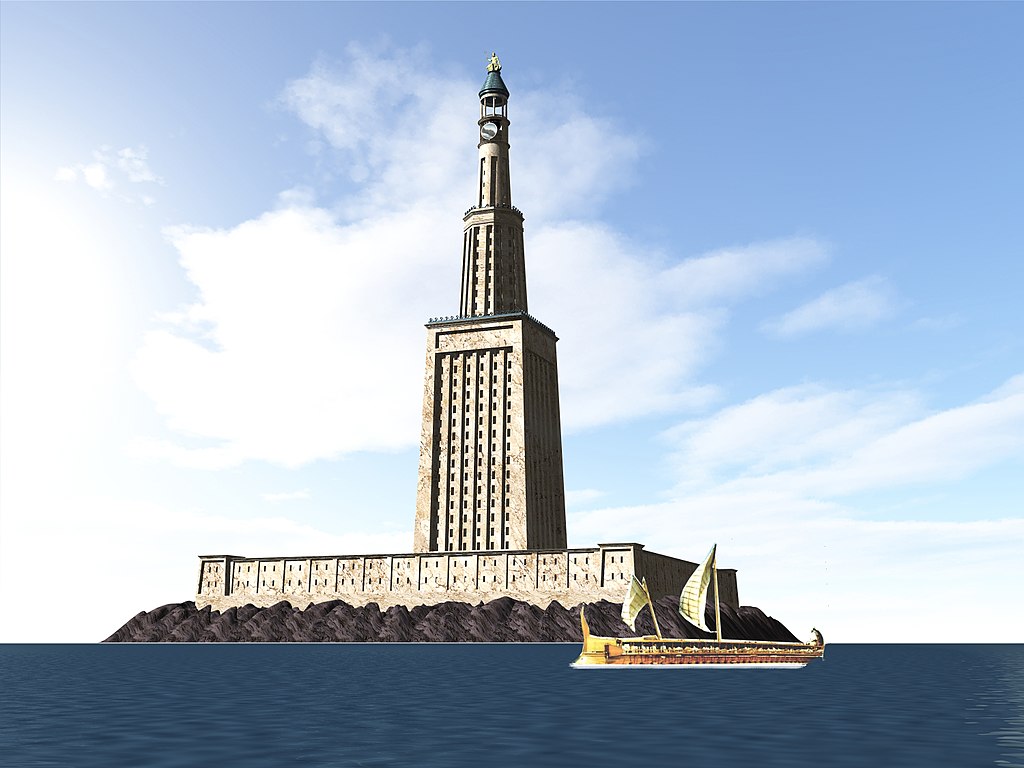
Of all of Antipater’s Seven Wonders of the World, the only one that has survived to the present day is the Great Pyramid of Giza. Its brilliant white stone facing had survived intact until around 1300 AD, when local people removed most of the stonework for building materials.
Among the only other surviving artifacts from the ancient wonders are sculptures from the tomb of Mausolus and the Temple of Artemis, which are currently housed in the British Museum in London.
Natural Human Urge to List most Spectacular Monuments
The urge to list of seven of the most magnificent architectural and artistic human achievements continued beyond Ancient Greek times to the Roman Empire, the Middle Ages, the Renaissance and even into the modern age.
Reflecting the rise of Christianity and the passage of time, the ravages of nature and the hand of man in destroying Antipater’s Seven Wonders, Roman and Christian sites began to figure on the list, including the Colosseum, Noah’s Ark and Solomon’s Temple in Jerusalem.
The original Seven Wonders have spawned innumerable versions of the best and most remarkable world monuments on the part of international organizations, publications and individuals, based on different themes, throughout the years.
Either works of nature, engineering masterpieces, or buildings from the Middle Ages, their purpose now has also changed from just pointing out the monuments that all cultured people must be aware of to a list of sites that must be defended or preserved from the passage of time and the depredations of man.
